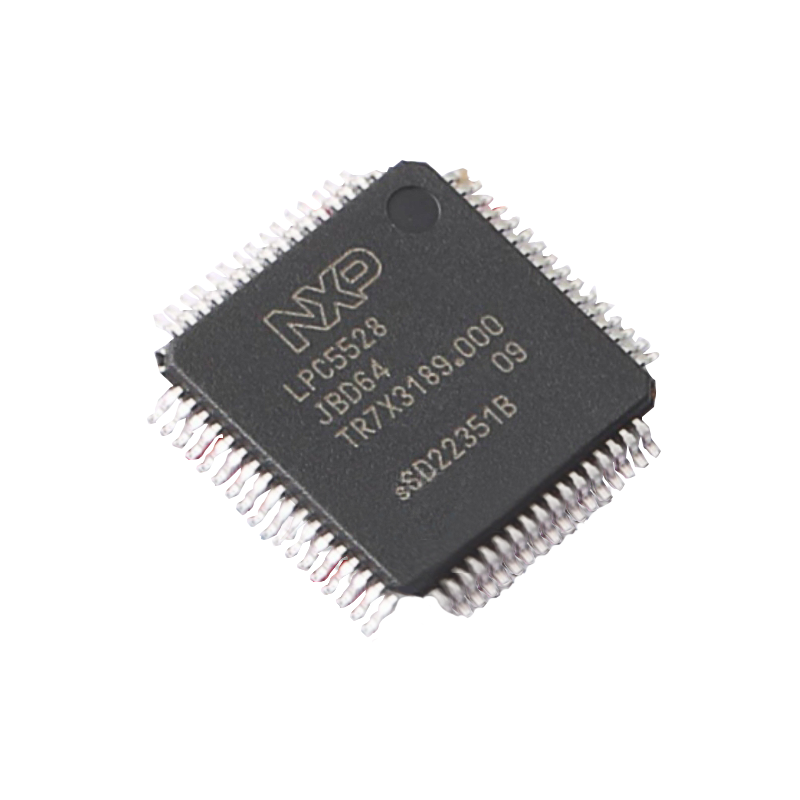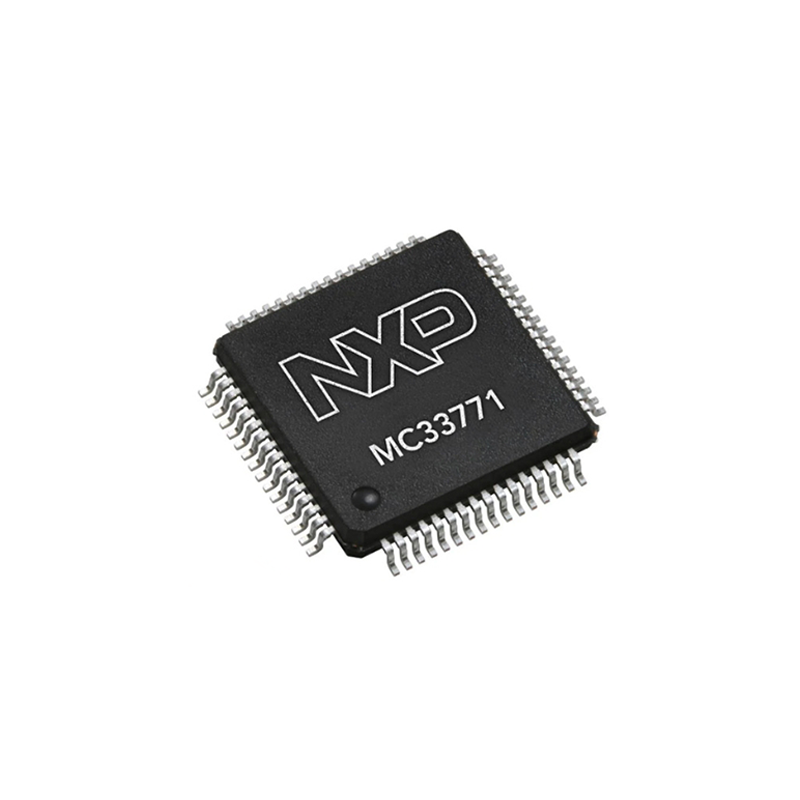- Sorry, this product cannot be purchased.
Product Details
NXP LPC5528JBD64Y MCU HTQFP64 ARM Cortex M33
LPC5528JBD64Y 32-bit Arm Cortex®-M33, CASPER, 256 KB SRAM; 512 KB flash, USB HS, Flexcomm Interface, SDIO, 32-bit counter/timers, SCTimer/PWM, PLU, 16-bit 1.0 Msamples/sec ADC, Comparator, Temperature Sensor, AES, PUF, SHA, CRC, RNG
The LPC5528JBD64Y is an ARM Cortex-M33 based microcontroller for embedded applications. These devices include a CASPER Crypto/FFT engine, up to 256 KB of on-chip SRAM, up to 512 KB on-chip flash, PRINCE module for on-the-fly flash encryption/decryption, high-speed and full-speed USB host and device interface with crystal-less operation for full-speed, SD/MMC/SDIO interface, five general-purpose timers, one SCTimer/PWM, one RTC/alarm timer, one 24-bit Multi-Rate Timer (MRT), a Windowed Watchdog Timer (WWDT), nine flexible serial communication peripherals (which can be configured as a USART, SPI, high speed SPI, I2C, or I2S interface), Programmable Logic Unit (PLU), one 16-bit 1.0 Msamples/sec ADC capable of simultaneous conversions, comparator, and temperature sensor. To support security requirements, the LPC55S2x also offers support for secure boot, HASH, AES, RSA, UUID, dynamic encrypt and decrypt, debug authentication, and TBSA compliance.
What is the difference between LPC5528JBD64K and LPC5528JBD64Y? The difference is MOQ, Y is 1500 per pack/K is 800 per pack.
Spot inventory with absolute price advantage, welcome to inquire
· ARM Cortex-M33 core (r0p3):
Running at a frequency of up to 150 MHz.
Memory Protection Unit (MPU).
ARM Cortex M33 built-in Nested Vectored Interrupt Controller (NVIC).
Non-maskable Interrupt (NMI) input with a selection of sources.
Serial Wire Debug with eight breakpoints and four watch points. Includes SerialWire Output for enhanced debug capabilities.
System tick timer.
The configuration of this instance includes MPU, FPU, DSP, and ETM.
· CASPER Crypto co-processor is provided to enable hardware acceleration for various functions required for certain asymmetric cryptographic algorithms, such as, Elliptic Curve Cryptography (ECC).
· On-chip memory:
Up to 512 KB on-chip flash program memory with flash accelerator and 512 byte page erase and write.
Up to 256 KB total SRAM consisting of 32 KB SRAM on Code Bus, 208 KB SRAM on System Bus (192 KB is contiguous), and additional 16 KB USB SRAM on System Bus which can be used by the USB interface or for general purpose use.
· PRINCE module for real-time encryption of data being written to on-chip flash and decryption of encrypted flash data during read to allow asset protection, such as securing application code, and enabling secure flash update.
· On-chip ROM bootloader supports:
Booting of images from on-chip flash
Supports CRC32 image integrity checking.
Supports flash programming through In System Programming (ISP) commands over following interfaces: USB0/1 interfaces using HID Class device, UART interface (Flexcomm 0) with auto baud, SPI slave interfaces (Flexcomm 3 or 9) using mode 3 (CPOL = 1 and CPHA = 1), and I2C slave interface (Flexcomm 1)
ROM API functions: Flash programming API, Power control API, and Secure firmware update API using NXP Secure Boot file format, version 2.0 (SB2 files).
Supports booting of images from PRINCE encrypted flash regions.
Support NXP Debug Authentication Protocol version 1.0 (RSA-2048) and 1.1 (RSA-4096).
Supports setting a sealed part to Fault Analysis mode through Debug authentication.
· Secure Boot support:
Uses RSASSA-PKCS1-v1_5 signature of SHA256 digest as cryptographic signature verification.
Supports RSA-2048 bit public keys (2048 bit modulus, 32-bit exponent).
Supports RSA-4096 bit public keys (4096 bit modulus, 32-bit exponent).
Uses x509 certificate format to validate image public keys.
Supports up to four revocable Root of Trust (RoT) or Certificate Authority keys, Root of Trust establishment by storing the SHA-256 hash digest of the hashes of four RoT public keys in protected flash region (PFR).
Supports anti-rollback feature using image key revocation and supports up to 16 Image key certificates revocations using Serial Number field in x509 certificate.
· Serial interfaces:
Flexcomm Interface contains up to nine serial peripherals (Flexcomm Interface 0-7 and Flexcomm Interface 8). Each Flexcomm Interface (except flexcomm 8, which is dedicated for high-speed SPI) can be selected by software to be a USART, SPI,
I2C, and I2S interface. Each Flexcomm Interface includes a FIFO that supports USART, SPI, and I2S. A variety of clocking options are available to each Flexcomm Interface, including a shared fractional baud-rate generator, and time-out feature.Flexcomm interfaces 0 to 7 each provide one channel pair of I2S.
I2C-bus interfaces support Fast-mode and Fast-mode Plus with data rates of up to 1Mbit/s and with multiple address recognition and monitor mode. Two sets of true I2C pads also support high-speed Mode (3.4 Mbit/s) as a slave.
USB 2.0 full speed host/device controller with on-chip PHY and dedicated DMA controller supporting crystal-less operation in device mode using software library example in technical note (TN00063).
USB 2.0 high-speed host/device controller with on-chip high-speed PHY.
· Digital peripherals:
DMA0 controller with 23 channels and up to 22 programmable triggers, able to access all memories and DMA-capable peripherals.
DMA1 controller with 10 channels and up to 15 programmable triggers, able to access all memories and DMA-capable peripherals.
Secured digital input/output (SD/MMC and SDIO) card interface with DMA support. SDIO with support for up to two cards. Supported card types are MMC, SDIO, and CE-ATA. Supports SD2.0, and SDR25 (52MHz).
CRC engine block can calculate a CRC on supplied data using one of three standard polynomials with DMA support.
Up to 64 General-Purpose Input/Output (GPIO) pins.
GPIO registers are located on the AHB for fast access. The DMA supports GPIO ports.
Up to eight GPIOs can be selected as pin interrupts (PINT), triggered by rising,falling or both input edges.
Two GPIO grouped interrupts (GINT) enable an interrupt based on a logical (AND/OR) combination of input states.
I/O pin configuration with support for up to 16 function options.
Programmable Logic Unit (PLU) to create small combinatorial and/or sequential logic networks including state machines.
· Security Features:
AES-256 encryption/decryption engine with keys fed directly from PUF or a software supplied key
Secure Hash Algorithm (SHA2) module supports secure boot with dedicated DMA controller.
Physical Unclonable Function (PUF) using dedicated SRAM for silicon fingerprint. PUF can generate, store, and reconstruct key sizes from 64 to 4096 bits. Includes hardware for key extraction.
True Random Number Generator (TRNG).
128 bit unique device serial number for identification (UUID).
Secure GPIO.
· Timers:
Five 32-bit standard general purpose asynchronous timers/counters, which support up to four capture inputs and four compare outputs, PWM mode, and external count input. Specific timer events can be selected to generate DMA requests.
One SCTimer/PWM with 8 input and 10 output functions (including 16 capture and match registers). Inputs and outputs can be routed to or from external pins and internally to or from selected peripherals. Internally, the SCTimer/PWM supports 16 captures/matches, 16 events, and 32 states.
32-bit Real-time clock (RTC) with 1 s resolution running in the always-on power domain. Another timer in the RTC can be used for wake-up from all low power modes including deep power-down, with 1 ms resolution. The RTC is clocked by the 32 kHz FRO or 32.768 kHz external crystal.
Multiple-channel multi-rate 24-bit timer (MRT) for repetitive interrupt generation at up to four programmable, fixed rates.
Windowed Watchdog Timer (WWDT) with FRO 1 MHz as clock source.
The Micro-Tick Timer running from the watchdog oscillator can be used to wake-up the device from sleep and deep-sleep modes. Includes 4 capture registers with pin inputs.
42-bit free running OS Timer as continuous time-base for the system, available in any reduced power modes. It runs on 32kHz clock source, allowing a count period of more than 4 years.
· Analog peripherals:
16-bit ADC with five differential channel pair (or 10 single-ended channels), and with multiple internal and external trigger inputs and sample rates of up to 1.0 MSamples/sec. The ADC support simultaneous conversions, on 2 ADC input channels belonging to a differential pair.
Integrated temperature sensor connected to the ADC.
Comparator with five input pins and external or internal reference voltage.
· Clock generation:
Internal Free Running Oscillator (FRO). This oscillator provides a selectable 96 MHz output, and a 12 MHz output (divided down from the selected higher frequency) that can be used as a system clock. The FRO is trimmed to +/- 2% accuracy over the entire voltage and -40 C to 105 C. For devices with date code 2041 (yyww)and onwards, the FRO is trimmed to +/- 1% accuracy over the entire voltage and 0 C to 85 C.
32 kHz Internal Free Running Oscillator FRO. The FRO is trimmed to +/- 2% accuracy over the entire voltage and temperature range.
Internal low power oscillator (FRO 1 MHz) trimmed to +/- 15% accuracy over the entire voltage and temperature range.
Crystal oscillator with an operating frequency of 16 MHz to 32 MHz. Option for external clock input (bypass mode) for clock frequencies of up to 25 MHz.
Crystal oscillator with 32.768 KHz operating frequency. Option for external clock input (bypass mode) for clock frequencies of up to 100 kHz.
PLL0 and PLL1 allows CPU operation up to the maximum CPU rate without the need for a high-frequency external clock. PLL0 and PLL1 can run from the internal FRO 12 MHz output, the external oscillator, internal FRO 1 MHz output, or the
32.768 KHz RTC oscillator.
Clock output function with divider to monitor internal clocks.
Frequency measurement unit for measuring the frequency of any on-chip or off-chip clock signal.
Each crystal oscillator has one embedded capacitor bank which can be used as an integrated load capacitor. Using APIs, the capacitor banks on each crystal pin can tune the frequency for crystals with a Capacitive Load (CL) which conserves board space and reduces costs.
· Power-saving modes and wake-up:
Integrated PMU (Power Management Unit) to minimize power consumption.
Reduced power modes: Sleep, deep-sleep with RAM retention, power-down with RAM retention and CPU retention, and deep power-down with RAM retention.
Configurable wake-up options from peripherals interrupts.
The Micro-Tick Timer running from the watchdog oscillator, and the Real-Time Clock (RTC) running from the 32.768 kHz clock, can be used to wake-up the device from sleep and deep-sleep modes.
Power-On Reset (POR, around 0.8 V).
Brown-Out Detectors (BOD) for VBAT_DCDC for forced reset or interrupt.
· Operating from internal DC-DC converter.
· Single power supply 1.8 V to 3.6 V.
· JTAG boundary scan supported.
· Operating temperature range 40 °C to +105 °C.
· Available in HLQFP100, HTQFP64, and VFBGA98 packages.
| Type | LPC5528JBD64Y |
| Manufacturer | NXP |
| Product Category | ARM Microcontrollers – MCU |
| Series | LPC552x |
| RoHS | Details |
| Mounting Style | SMD/SMT |
| Package / Case | HTQFP-64 |
| Core | ARM Cortex M33 |
| Program Memory Size | 512 kB |
| Data Bus Width | 32 bit |
| ADC Resolution | 16 bit |
| Maximum Clock Frequency | 150 MHz |
| Number of I/Os | 36 I/O |
| Data RAM Size | 256 kB |
| Supply Voltage – Min | 1.8 V |
| Supply Voltage – Max | 3.6 V |
| Minimum Operating Temperature | – 40°C |
| Maximum Operating Temperature | + 105°C |
| Packaging | Tray |
| Data RAM Type | SRAM |
| Interface Type | I2C, I2S, SDIO, SPI, USART, USB |
| Moisture Sensitive | Yes |
| Number of ADC Channels | 5 Channel |
| Number of Timers/Counters | 5 Timer |
| Operating Supply Voltage | 1.8 V to 3.6 V |
| Product | MCU+FPUs |
| Program Memory Typ | Flash |
| MOQ | 1500 |







